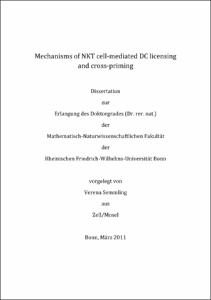Semmling, Verena: Mechanisms of NKT cell-mediated DC licensing and cross-priming. - Bonn, 2012. - Dissertation, Rheinische Friedrich-Wilhelms-Universität Bonn.
Online-Ausgabe in bonndoc: https://nbn-resolving.org/urn:nbn:de:hbz:5n-27455
Online-Ausgabe in bonndoc: https://nbn-resolving.org/urn:nbn:de:hbz:5n-27455
@phdthesis{handle:20.500.11811/5261,
urn: https://nbn-resolving.org/urn:nbn:de:hbz:5n-27455,
author = {{Verena Semmling}},
title = {Mechanisms of NKT cell-mediated DC licensing and cross-priming},
school = {Rheinische Friedrich-Wilhelms-Universität Bonn},
year = 2012,
month = jan,
note = {The detection and destruction of virus-infected or tumor cells is the main task of CD8+ T cells. Their activation needs to be tightly regulated to avoid the misguided killing of healthy cells. To this end, activation of CD8+ T cells requires not only antigenic signals but also additional costimulatory signals provided by mature DCs. The process that renders DCs capable of cross-priming has been termed DC licensing and can be induced by antigen-specific interactions with CD4+ TH cells. As the frequencies of specific antigen-bearing DCs and the relevant antigen-specific naïve CD4+ and CD8+ T cells are low, the involvement of chemokines as regulators of cell-cell interactions seems likely. Indeed, CCR5 has been described to be upregulated on naïve CD8+ T cells, thereby attracting these cells to the site of DC–CD4+ TH cell interactions, where the CCR5 ligands CCL3 and CCL4 are produced. Recently it has been established that not only CD4+ TH cells but also NKT cells can provide help for DC maturation, but the exact mechanisms remain unclear.
The present study characterizes NKT cell-mediated DC licensing and presents a new aspect of DC licensing by demonstrating that the presentation of glycolipid antigens by DCs to NKT cells resulted not only in DC maturation but also in the expression of the chemokine CCL17 by the antigen-presenting DC. Moreover, it establishes that the induction of this chemokine is a critical component of DC licensing and is crucial for the generation of efficient CD8+ T cell responses, as the lack of CCL17 or its receptor CCR4 strongly impaired cross-priming. Several possible mechanisms for impaired cross-priming were investigated. Published findings of others made an effect on DCs and NKT cells most likely, but this was not the case. Instead, CCL17 increased the efficiency of cross-priming by acting directly on CD8+ T cells. Several experimental approaches revealed that CD8+ T cells that had upregulated CCR4 in response to a yet unknown factor were attracted by CCL17 towards licensed DCs. Additionally, CCL17 increased the DC–CD8+ T cell contact duration, thus promoting efficient scanning of the DC surface and enhancing the chances of efficient cross-presentation.
These results identify CCL17 – CCR4 as a second chemokine – chemokine receptor pair that regulates cross-priming. Furthermore, they uncovered a previously unrecognized role of CCL17 and CCR4 in cytotoxic T cell responses. Finally, these results demonstrated that the two chemokine mechanisms that regulate classical and NKT cell-mediated cross-priming act in a synergistic manner by further increasing the efficiency of CD8+ T cell responses. Understanding the molecular mechanism of this synergistic effect may help improving vaccination strategies.},
url = {https://hdl.handle.net/20.500.11811/5261}
}
urn: https://nbn-resolving.org/urn:nbn:de:hbz:5n-27455,
author = {{Verena Semmling}},
title = {Mechanisms of NKT cell-mediated DC licensing and cross-priming},
school = {Rheinische Friedrich-Wilhelms-Universität Bonn},
year = 2012,
month = jan,
note = {The detection and destruction of virus-infected or tumor cells is the main task of CD8+ T cells. Their activation needs to be tightly regulated to avoid the misguided killing of healthy cells. To this end, activation of CD8+ T cells requires not only antigenic signals but also additional costimulatory signals provided by mature DCs. The process that renders DCs capable of cross-priming has been termed DC licensing and can be induced by antigen-specific interactions with CD4+ TH cells. As the frequencies of specific antigen-bearing DCs and the relevant antigen-specific naïve CD4+ and CD8+ T cells are low, the involvement of chemokines as regulators of cell-cell interactions seems likely. Indeed, CCR5 has been described to be upregulated on naïve CD8+ T cells, thereby attracting these cells to the site of DC–CD4+ TH cell interactions, where the CCR5 ligands CCL3 and CCL4 are produced. Recently it has been established that not only CD4+ TH cells but also NKT cells can provide help for DC maturation, but the exact mechanisms remain unclear.
The present study characterizes NKT cell-mediated DC licensing and presents a new aspect of DC licensing by demonstrating that the presentation of glycolipid antigens by DCs to NKT cells resulted not only in DC maturation but also in the expression of the chemokine CCL17 by the antigen-presenting DC. Moreover, it establishes that the induction of this chemokine is a critical component of DC licensing and is crucial for the generation of efficient CD8+ T cell responses, as the lack of CCL17 or its receptor CCR4 strongly impaired cross-priming. Several possible mechanisms for impaired cross-priming were investigated. Published findings of others made an effect on DCs and NKT cells most likely, but this was not the case. Instead, CCL17 increased the efficiency of cross-priming by acting directly on CD8+ T cells. Several experimental approaches revealed that CD8+ T cells that had upregulated CCR4 in response to a yet unknown factor were attracted by CCL17 towards licensed DCs. Additionally, CCL17 increased the DC–CD8+ T cell contact duration, thus promoting efficient scanning of the DC surface and enhancing the chances of efficient cross-presentation.
These results identify CCL17 – CCR4 as a second chemokine – chemokine receptor pair that regulates cross-priming. Furthermore, they uncovered a previously unrecognized role of CCL17 and CCR4 in cytotoxic T cell responses. Finally, these results demonstrated that the two chemokine mechanisms that regulate classical and NKT cell-mediated cross-priming act in a synergistic manner by further increasing the efficiency of CD8+ T cell responses. Understanding the molecular mechanism of this synergistic effect may help improving vaccination strategies.},
url = {https://hdl.handle.net/20.500.11811/5261}
}






